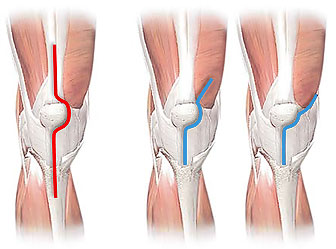Joint (Knee & Hip) Replacement Implants: based on the need of the patient and the procedure performed, specific type of knee replacement implants is used. There are many different categories of implants available. Knee joint is the strongest and also the largest joint in the body, thus the implants also gain some complexity.
History of Implants: Initially, the implants were made on similar to knee joint which is a hinge joint and had a hinge connecting the parts. But with advances in medical technology, the newer designs closely mimic the complexity of knee joints. There are over 150 knee implant designs and they are also increasingly becoming gender-specific. Some ligaments are so complex that they provide substitute for supporting ligaments.
Components of knee implants: similar to a knee joint, even a knee implant has 3 components
- The femoral end component is metal part which is grooved to provide smooth knee bending function.
- The tibial top surface component is a flat metal platform and has a polyethylene cushion. The metal portion in some designs has a stem (revision surgery) for stability. Sometimes also the plastic is attached directly to the bone.
- The patella back surface is polyethylene which is dome shaped and replicates knee cap structure.
Types of Prosthesis: Mobile bearing and Fixed Bearing Prosthesis
- Fixed bearing prosthesis is strong, durable and most commonly put but mostly in old age patients. This fixed bearing prosthesis has metal implant beneath to which the polyethylene of the tibial is fixed firmly.
- Mobile bearing prosthesis is preferred for younger patients with healthier supporting tissues like ligaments. In it the tibial polythelene component can rotate for short distances inside of the metal tray.
Materials used in implants:
Metal: this is cobalt chromium based or titanium alloy.
Plastic: polyethylene of ultra high molecular weight quality.
Weight: 15-20 ounces depending on the size selected.
Selection of material for implant components is based on:
- Structure of the knee component being replicated with the design
- Weight bearing, flexibility, function of that particular component in that design
- Durability, original form maintenance based on function of the implant
- Biocompatibility to prevent implant rejection.
Fixing of implants:
- Bone cement of polymethyl metha acrylate is used to fix the prosthesis in the bone.
- Cementless has components promoting bone growth in the implant to fix the prosthesis to the bone.
- Hybrid – femoral end component is cementless and patellar & tibial fixed with cement.
Fixing/stabilization of the implants: this can be posterior stabilized or cruciate retaining stabilization.
In posterior stabilized designs, the posterior cruciate ligament is replaced with prosthesis parts to prevent the abnormal forward sliding of thigh bone. In cruciate retaining component, this ligament is not removed as it is healthy and strong enough to support & stabilize the implant.
Implants used in Unicompartmental surgery are large if both the femur and tibia ends are damaged and need replacement while smaller implants are used when the damage is only to one side of the joint.
Revision surgery implant Components: are made up prosthesis with longer stems for improved fixation and stability which fit into the tibia and femur.




